Student Design Contest in IEEE PrimeAsia 2022
The IEEE PrimeAsia 2022 has successfully organized a Student Design Contest on Intelligent Sensing/Processing Circuits and Systems for Automobile and Mobile Robot Applications, in Shenzhen on November 11-13, 2022. The PrimeAsia Student Design Competition (SDC) is jointly initiated by IEEE CASS-EDS-SSCS Wuhan Joint Chapter and IEEE Shanghai Section Young Professional Affinity Group to provide opportunity for postgraduate students (Masters and Ph.D) to present their research work and to interact with scientists and engineers in the research community and industry. This platform provides visibility to postgraduate students in the early stage of their career, benchmark postgraduate research in a friendly and cooperative environment, and connect postgraduate students with academic/research institutions and the industry. Gold, Silver and Bronze Leaf Certificates are awarded to the student authors based on the merit of technical contributions, paper and presentation quality. Based on the demonstration results, three best student designs are selected and awarded. The other participants will be honored with PrimeAsia SDC certificates. The PrimeAisa SDC 2022 was proposed and organized by the IEEE CASS-EDS-SSCS Wuhan Joint Chapter Chair Chao Wang and the IEEE Shanghai Section Young Professional Affinity Group Chair Jian Zhao. The financial sponsor is Chipsea Technologies Corp., Shezhen, China.
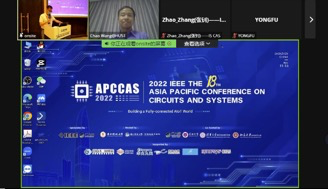
Figure 1 (Left) –The opening ceremony of the PrimeAsia Student Design Contest is chaired by Prof. Chao Wang and Prof. Jian Zhao in a hybrid meeting.
The final competition was held by the Chair Prof. Chao Wang from Huazhong University of Science and Technology and the Co-chair Prof. Jian Zhao from Shanghai Jiao Tong University in hybrid format (onsite and virtual), from 16:30 to 18:00 (GMT+9) on Nov. 11 during the IEEE APCCAS conference 2022 and IEEE PrimeAsia conference 2022. During the live session, each team had 20 minutes for a demo presentation and 10 minutes for QA. The schedule of the SDC presentation is shown in Fig.2.
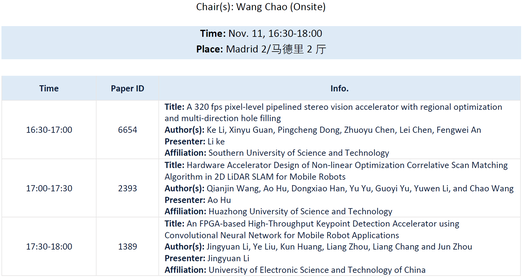
Figure 2 (Right) – The schedule of the presentation of the Student Design Contest.
The first presentation was given by Ms. Li Ke from Southern University of Science and Technology, titled “A 320 fps pixel-level pipelined stereo vision accelerator with regional optimization and multi-direction hole filling”. She introduced a fully parallel initial matching costs calculation architecture and a two-layer parallel two-stage pipeline structure, which ensures synchronization of the pixel stream and mitigates the high computational complexity.
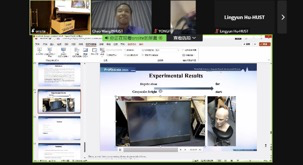
Figure 3 (Left) – Ms. Li Ke was introducing the experiment results of the proposed vision accelerator.
The second presenter was Mr. Ao Hu from Huazhong University of Science and Technology, who introduced an efficient hardware accelerator design of non-linear optimization correlative scan matching algorithm in 2D LiDAR SLAM for mobile robots. The proposed NLO-CSM algorithm hardware accelerator utilizes pipeline processing and module reusing to achieve low power consumption, fast matching and high area efficiency, while ensuring high calculation accuracy.
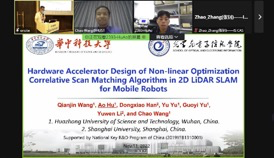
Figure 4 (Left) – Mr. Ao Hu was introducing the proposed NLO-CSM algorithm hardware accelerator.
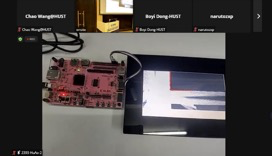
Figure 5 (Left) – Mr. Ao Hu was presenting the FPGA demo of the proposed hardware accelerator.
The last presentation was given by Mr. Jingyuan Li from University of Electronic Science and Technology of China, titled “An FPGA-based high-throughput keypoint detection accelerator using convolutional neural network for mobile robot applications”. He showed a FPGA-based high-throughput keypoint detection accelerator using CNN with algorithm-hardware co-design, including a lightweight keypoint detection neural network and a dedicated hardware accelerator architecture.
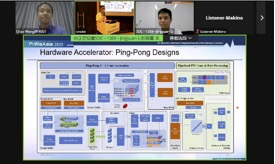
Figure 6 (Right) –Mr. Jingyuan Li was introducing the FPGA-based high-throughput keypoint detection accelerator.
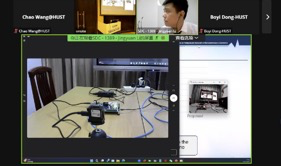
Figure 7 (Left) – Mr. Jingyuan Li was presenting the FPGA demo of the proposed hardware accelerator.
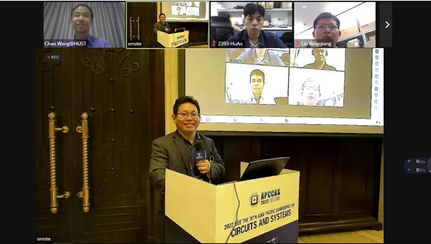
Figure 8 (Right) – The PrimeAsia SDC 2022 has successfully attracted more than 50 audiences and finally concluded by the TPC Chair Prof. Yongfu Li (onsite) and SDC Chair Prof. Chao Wang (online).
During the final competition, more than 10 judges have been invited to evaluate the finalist works. The final winner result was announced during the APCCAS Closing Ceremony on November 13. Mr. Jingyuan Li from University of Electronic Science and Technology of China won the gold award for his excellent work and presentation, while Mr. Ao Hu from Huazhong University of Science and Technology and Ms.Li ke from Southern University of Science and Technology won the silver and bronze awards, respectively. The awards were sponsored by Chipsea Technologies Corp., which is a famous signal chain integrated circuit design enterprise based in Shezhen, China. It is worth mentioning that the PrimeAsia Student Design Contest 2022 was a big success, which not only expanded the influence of the IEEE CAS Society, but also provided a great opportunity for young postgraduate students to present their research work and communicate with each other, and deepened the bonding between the academic/research institutions and industry.
This article was contributed by
Ao Hu and Chao Wang
__________
5th IBM IEEE CAS/EDS AI Compute Symposium (AICS’22)
The 5th IBM IEEE CAS/EDS AI Compute Symposium, known as (AICS’22), was held for two days (11-12 Oct 2022) at the IBM T. J. Watson Research Center. The symposium was also supported by the IBM Academy of Technology (https://www.ibm.com/blogs/academy-of-technology/). Dr. Joshi was the interface for CAS and EDS in organizing this successful event. The theme of the symposium was “Scalability to Sustainability”. In short, the symposium covered a range of topics from device technology, to circuits, architecture, algorithms, and sustainability to make innovations for the cloud with an emphasis on green AI.
For the third straight year, the symposium provided a virtual access option, allowing an increase in attendance. The event was very well attended and received great responses from the audience all over the world. Close to 1000 viewers for two days, participation from 50 countries, over 30 student posters, best poster awards, excellent panel discussions, and 11 distinguished speakers from industry and academia were the salient features of this symposium. There were more than 2600 views on the LinkedIn post about the symposium.
At the beginning, Dr. Rajiv Joshi, lead organizer, and IEEE Life Fellow, gave welcoming remarks, a short history, progress, and the impact of the symposium.
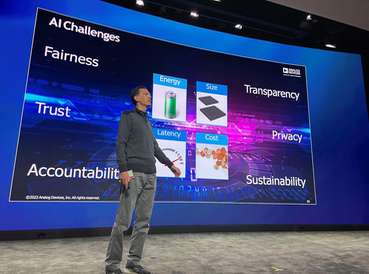
Robert Muchsel, ADI highlighting AI Challenges (Right Photo)
Then Robert Muchsel, Analog Devices fellow, opened the symposium with an excellent presentation related to “Improving Privacy and Energy Usage by Pushing AI Inference to the Edge of the IoT Frontier”. Although artificial intelligence dominates the tech news, most AI solutions are expensive, big, and energy hungry. The connected nature of these systems also leads to significant concerns relating to privacy and system autonomy. Mr. Muchsel described ADI’s true edge AI accelerators, which employ many low-power innovations to enable AI inference on a battery while improving privacy through local computing at the edge.
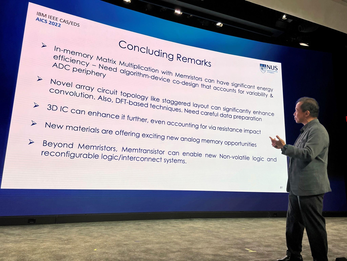
Prof. Aaron Thean, National University of Singapore presents concluding remarks (Left Photo)
Prof. Aaron Thean, the Dean of the College of Design and Engineering at the National University of Singapore (NUS), followed up with an exciting talk related to “Novel Material-System Co-Design Opportunities for Analog-Non-Volatile In-Memory Computing and Reconfigurable Edge-AI”. Ultra-low energy and area-efficient electronic systems are required to enable untethered computing at the edge of IoT. To realize self-learning edge-AI systems, conventional solely software-driven deep-learning neural networks become a major roadblock due to the excessive energy expense of training. Hence, fundamental hardware change is likely needed. In this talk, Dr. Thean reviewed how recent material innovations (e.g. Ferroelectric oxides and 2D Material) coupled with new micro-architecture innovations (e.g. novel memory physical layout and monolithic 3D IC) may significantly accelerate in-memory computation. His talk covered wafer-level solution-processed CMOS-compatible use of 2D material (MoS2/WSe2) to enable high-endurance memristors that can have properties superior to conventional oxide RRAMs. Through material-device-aware data encoding, error correction, and novel physical memory layout (staggered + Manhattan arrays), this work aims to simplify the in-memory data process. Dr. Thean showed how one can significantly manage variabilities while accelerating convolution deep neural network operations and offering substantial low-energy opportunities for Edge-AI systems.
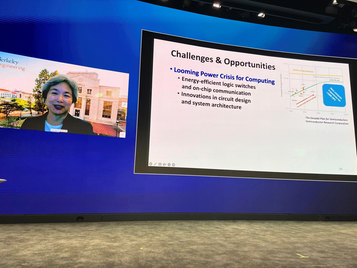
Prof. Tsu-Jae King Liu, University of California, Berkeley, showcasing challenges and opportunities in her talk Technology and Innovation (Right Photo)
Subsequently, Prof. Tsu-Jae King Liu, Dean of the College of Engineering, University of California, Berkeley gave a very interesting talk about “Technology Co-Design and Innovation for the Age of Ambient Intelligence”. As practical limits for transistor miniaturization are reached, alternative approaches for improving integrated circuit functionality and energy efficiency at acceptable cost will be necessary to meet the growing demand for information and communication technology. This presentation showcased how technology co-design and innovation can achieve dramatic improvements in computing performance to usher in the “Age of Ambient Intelligence.”
Then Bill Luan, Senior Program Manager, Coral team at Google talked about “Using Coral for Scalable and Sustainable AI at the Edge”. With the advancement in AI research over the past decade, AI/ML technology has expanded from being only available on cloud-based data centers to becoming available on IoT and edge devices, opening huge opportunities for innovations. Leading this change is the Coral platform from Google, making deploying AI at the edge on a large scale not only possible but also sustainable. This presentation covered the Coral platform in detail, including product features and applications by businesses around the world that are leveraging Coral for deploying innovative edge AI solutions at scale.
Next, Arun Venkatachar, Vice President of AI, Cloud, and Central Engineering Synopsys Inc., gave a wonderful talk related to the “Confluence of AI & Cloud with EDA”. Investments in AI/ML/Cloud/Big Data to solve EDA problems with ever-increasing complexities of chip design are starting to come to light. Recent product announcements like the DSO.ai from Synopsys revolutionizes chip design by massively scaling the exploration of options in design workflows. Similarly, there are many applications in production solving different challenges in areas like verification, place & route, manufacturing, etc., that have harnessed the power of AI/ML, Big-data and computing to provide a new set of tools and techniques for EDA to address both existing and new challenges. His overall suggestion to other companies is to build good data strategies and compute utilization approaches to harness these benefits across their organizations. They will also need to invest in good data and AI/ML and cloud infrastructures to expedite building these solutions.
The final talk on day one was given by Prof. Jason Cong, Director of the Center for Domain-Specific Computing (CDSC) and Director of the VLSI Architecture, Synthesis, and Technology (VAST) Laboratory at UCLA. The talk focused on “Automated Synthesis and Architecture Optimization for Deep Learning Accelerator Designs”. AutoSA is an automated compilation framework for generating systolic arrays, and a core acceleration engine for most deep-learning applications. AutoSA is based on the polyhedral framework and incorporates a set of techniques for both computation and communication optimizations. Based on AutoSA, an automated, efficient, and comprehensive design space exploration is performed to achieve optimal systolic array designs for deep learning applications. Dr. Cong’s study revealed that a number of widely used heuristics based on “common sense” often lead to sub-optimal solutions, such as limiting to loop count divisors for tiling and pruning based on off-chip data movement minimization. Finally, he showed AutoSA integrated into an end-to-end acceleration framework for deep learning using a flexible and composable architecture called FlexCNN. This approach can deliver high computation efficiency for different types of convolution layers using techniques such as dynamic tiling and data layout optimization. AutoSA and FlexCNN are both open-source projects.
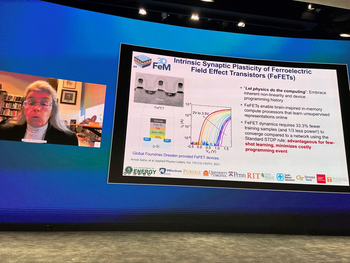
Prof. Susan Trolier-McKinstry, Pennsylvania State University describing Ferro-electric materials and their applications.
Prof. Susan Trolier-McKinstry, an Evan Pugh University Professor and Steward S. Flaschen Professor of Ceramic Science and Engineering at The Pennsylvania State University, opened the second day with developments in “New Materials for Three Dimensional Ferroelectric Microelectronics”. In the last decade, there have been major changes in the families of ferroelectric materials available for integration with CMOS electronics. These new materials, including Hf1-xZrxO2, Al1-xScxN, Al1-xBxN, and Zn1-xMgxO, offer the possibility of new functionalities. This talk discussed the possibility of exploiting the 3rd dimension in microelectronics for functions beyond interconnects, enabling 3D non-von Neumann computer architectures exploiting ferroelectrics for local memory, logic in memory, digital/analog computation, and neuromorphic functionality. This approach circumvents the end of Moore’s law in 2D scaling, while simultaneously overcoming the “von Neumann bottleneck” in moving instructions and data between separate logic and memory circuits. Computing accounts for 5 – 15% of worldwide energy consumption. In the U.S., data centers alone are projected to consume approximately 73 billion kWh in 2020. While recent efficiency gains in hardware have partially mitigated the rising energy consumption of computing, major gains are achievable in a paradigm shift to 3D computing systems, especially those that closely couple memory and logic. Dr. Trolier-McKinstry’s talk covered the relevant materials, their deposition conditions, and what is known about the wake-up, fatigue, and retention processes.
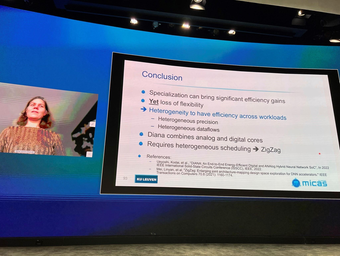
Prof. Marian Verhelst, KU Leuven concluding her talk (Left Photo)
Next, Marian Verhelst, Professor at the MICAS laboratories of KU Leuven and a research director at IMEC, gave a talk related to tinyML, “Heterogeneous Multi-Core tinyML”. She described approaches for powerful machine inference in resource-scarce distributed devices. Developing intelligent applications at ultra-low energy and low latency requires compact compute and memory structures that have very high utilization. This has resulted in a wide variety of proposed state-of-the-art accelerator designs. However, it becomes increasingly clear that intelligent edge devices will need to be equipped with a diverse set of many heterogeneous co-processors, which allow running every workload on the most compatible (combination of) accelerators. Moreover, by using multiple cores in parallel and streaming data between the cores, the required amount of on-chip memory and IO bandwidth can be reduced, leading to area, energy, and latency savings. Dr. Verhelst’s talk explained the benefits and challenges of such heterogeneous ML systems, and how they allow scaling up performance at low budgets.
Dr. Steve Teig, CEO of Perceive, enlightened the audience with “Machine Learning for Real: Thinking More Carefully About Efficiency, Loss Functions, and GANs”. Deep learning seems to touch every discipline these days, but behind its startling magic tricks, it is surprisingly primitive. It is concerning to note the extent to which today’s deep learning relies on folklore: on recipes and anecdotes, rather than on scientific principles and explanatory mathematics. We can only imagine how much more trustworthy, robust, compact, and power-efficient our models would be if we designed them more rigorously. Dr. Teig’s assertions were accompanied by some motivating (and occasionally humorous) examples.
Then Dr. Stefanie Chiras, Senior Vice-President, Partner Ecosystem Success, Red Hat, gave a very interesting talk about “AI at the Open Edge”. Complex use cases and game-changing potential collide when AI is delivered at the edge. This creates a perfect P etri dish for innovation, not only at the technology level but in how different skills and disciplines collaborate. Building frameworks, architectures, and services can reduce the complexity and enable businesses to extract actionable insights by processing data closer to devices, sensors, and other sources. Red Hat sees this opportunity as an extension of the open hybrid cloud, bringing capability all the way out to the far edge…even as far as the International Space Station.
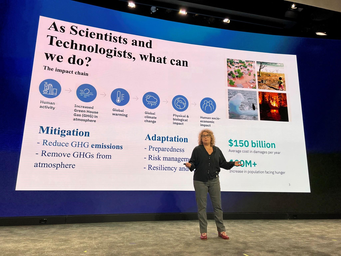
Dr. Tamar Eilam, IBM, emphasizing the need for sustainability (Right Photo)
Finally, Dr. Tamar Eilam, IBM Fellow, gave a talk on “The Road to Sustainable Computing”. She presented IBM’s initiative related to sustainable and responsible computing. Dr. Eilam described how to design a sustainable data center. Key important steps include finding pathways to achieve multi-DC sustainability goals incorporating exogenous factors, natural resources, cooling, water, energy for IT, and other constraints within a holistic DC Model. She also emphasized the importance of explainable AI, and contra-factual analysis with a focus on capital and operational cost with environmental impacts, such as, capitalized carbon footprint emissions, operational carbon footprint, and operational water use. Dr. Eilam pointed out the need for utilizing renewable energy, such as solar, wind, wave, etc., energy storage mediums, software platforms, infrastructure, and water usage and heat wastage. The key lies in utilizing sustainable computing by predicting the power consumption, co-optimization of software/system-based behavior, and coupling renewable energy.
The Poster Session followed by the keynote talks on day 1 of the symposium. Out of 32 posters, the best posters were awarded from each of the 3 tracks. The list of winners is given on the symposium website.
The symposium closed with a panel discussion on sustainability, with five distinguished panelists including Mr. Robert Muchsel (ADI), Dr. Tamar Eilam (IBM), Prof. Christopher Hill (MIT), Prof. Prashant Shenoiy (University of Massachusetts), and Prof. Aaron Thean (National University of Singapore). Panelists discussed sustainability at all levels, including algorithmic and architecture techniques, data center carbon footprint reduction, product development, and applications where AI can help. Replays of the entire two-day symposium are available on the symposium website:
https://www.zurich.ibm.com/thinklab/AIcomputesymposium.html
Executive Sponsor – Dr. Mukesh Khare
Sponsors – IEEE CAS and EDS
AoT Sponsor – Dr. John “Boz” Handy Bosma
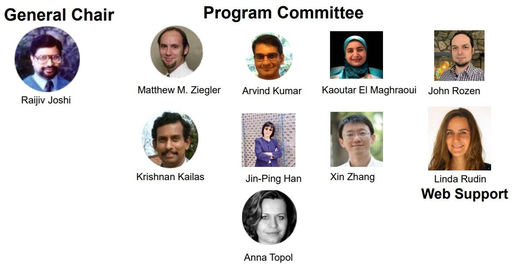
This article was contributed by
Rajiv Joshi (IEEE Life Fellow), Kaoutar El Maghraoui, Arvind Kumar, and Matthew Ziegler
T. J. Watson Research Center, Yorktown Heights, NY 10598